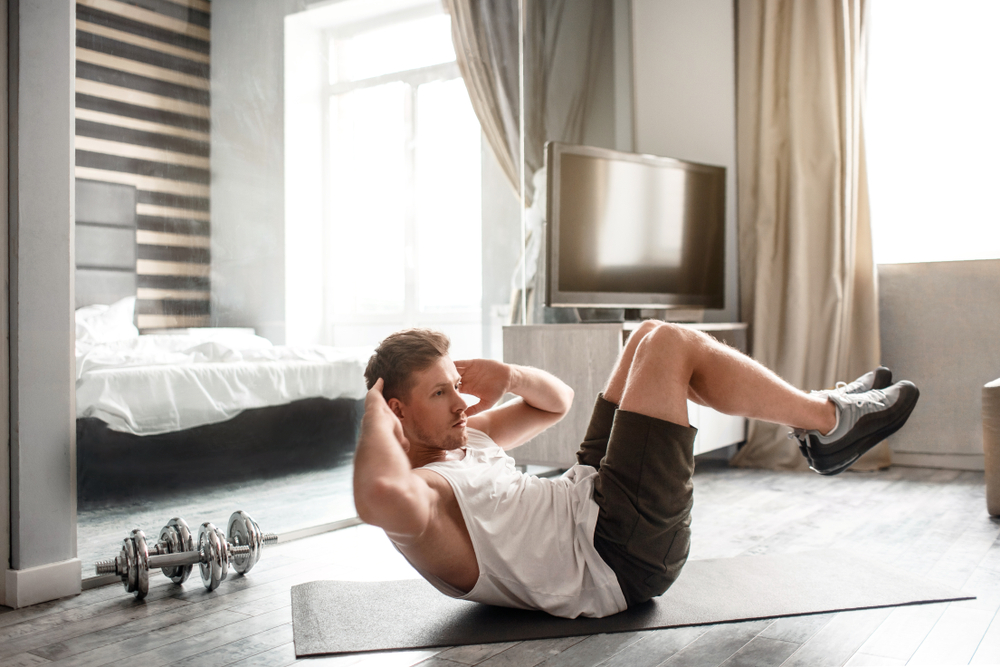In a world where busy schedules, limited access to gyms, and evolving lifestyles have reshaped the way we approach fitness, home workouts have emerged as a powerful, flexible solution for staying active and healthy. Whether you’re a working professional with limited time, a parent juggling multiple responsibilities, or someone simply looking to stay fit in a more personal space, home workouts provide the freedom to exercise anytime, anywhere—without the pressure of a crowded gym.
Staying fit doesn’t necessarily require high-end machines or personal trainers. With the right approach, home workouts can be just as effective—if not more—than traditional gym sessions. In fact, working out in your own environment allows you to design routines that match your personal fitness level, goals, and lifestyle. From bodyweight exercises to yoga flows, cardio bursts to strength training circuits, the variety is endless.
Moreover, staying fit at home doesn’t only support physical health. It enhances mental clarity, reduces stress, boosts energy levels, and builds discipline. In an era where self-care and well-being are paramount, adopting a consistent home fitness routine is one of the most empowering decisions you can make for yourself.
In this article, we’ll dive deep into how you can stay fit with home workouts, the benefits of doing so, how to structure your routine, overcome common obstacles, and answers to frequently asked questions. Whether you’re a beginner or someone looking to revamp your regimen, this guide will equip you with the tools and motivation to take control of your fitness journey—right from your living room.
Key Takeaways
- Accessibility: Home workouts are convenient and can be tailored to individual needs.
- Variety: A mix of exercises prevents monotony and targets different muscle groups.
- Consistency: Regular routines lead to better results and habit formation.
- Adaptability: Overcome challenges by modifying routines and staying committed.
- Community: Engaging with others can provide support and enhance motivation.
Understanding the Benefits of Home Workouts
Cost-Effective
Traditional gym memberships can be expensive, with additional costs for commuting and time. Home workouts eliminate these expenses, allowing you to invest in affordable equipment like resistance bands or dumbbells, or even utilize bodyweight exercises that require no equipment. This affordability makes fitness accessible to a broader range of individuals.
Convenience and Time-Saving
Exercising at home removes the need to travel to a gym, saving time and making it easier to fit workouts into your schedule. Whether it’s early morning or late evening, you have the flexibility to choose a time that works best for you. This convenience ensures that fitness becomes a consistent part of your daily routine.
Privacy and Comfort
Many individuals feel self-conscious working out in public gyms. At home, you can exercise in a private space, wear comfortable attire, and engage in routines without the fear of judgment. This privacy can lead to increased confidence and a more enjoyable workout experience.
Variety and Customization
Home workouts allow you to tailor your exercise routine to your preferences and goals. Whether you’re interested in strength training, cardio, yoga, or a combination, you have the freedom to design a program that suits your needs. This customization ensures that your workouts remain engaging and aligned with your fitness objectives.
Essential Components of an Effective Home Workout Routine

To ensure a balanced and effective home workout routine, incorporate the following components:
Warm-Up
Begin with 5-10 minutes of light cardio or dynamic stretches to prepare your body and reduce the risk of injury. Warming up increases blood flow to muscles, raises body temperature, and enhances flexibility, setting the stage for a more effective workout.
Strength Training
Engage in exercises that target major muscle groups. Bodyweight exercises like squats, push-ups, and lunges are excellent, and adding resistance bands or dumbbells can enhance intensity. Strength training builds muscle mass, boosts metabolism, and improves overall strength.
Cardio
Activities such as jumping jacks, high knees, or stair climbing elevate your heart rate and improve cardiovascular health. Cardiovascular exercises enhance endurance, support heart health, and aid in calorie burning.
Flexibility and Balance
Incorporate yoga or Pilates to enhance flexibility, balance, and mental well-being. Stretching exercises improve range of motion, reduce muscle tension, and promote relaxation.
Cool Down
End with static stretches to relax muscles and improve flexibility. Cooling down helps lower heart rate, prevent muscle stiffness, and aids in recovery after intense workouts.
Sample Weekly Home Workout Plan
This plan balances strength, cardio, flexibility, and recovery to help you stay fit at home with minimal or no equipment. You can repeat this weekly or adapt it based on your goals.
| Day | Focus | Activities | Details |
|---|---|---|---|
| Monday | Full Body Strength | Squats, push-ups, planks, burpees | Perform 3–4 rounds of 10–15 reps of each exercise. This total-body circuit builds strength, endurance, and engages multiple muscle groups. |
| Tuesday | Cardio & Core | Jump rope, mountain climbers, bicycle crunches | Do 30–45 seconds of each exercise, repeat for 3–4 rounds. This mix burns fat and strengthens your abdominal muscles. |
| Wednesday | Active Recovery | Gentle yoga, mobility work, or light stretching | Spend 20–30 minutes focusing on flexibility and muscle recovery. Follow a guided routine or stretch each major muscle group. |
| Thursday | Lower Body Strength | Lunges, glute bridges, calf raises, wall sits | Do 3 sets of 12–15 reps. Use dumbbells or resistance bands for added difficulty. Focus on proper form and control. |
| Friday | Upper Body Strength | Tricep dips (on a chair), shoulder presses (with dumbbells or water bottles), bicep curls | 3 sets of 10–12 reps each. Target the arms, shoulders, and chest. Use household items if equipment is unavailable. |
| Saturday | Cardio Intervals | HIIT routine: high knees, squat jumps, jumping jacks, rest, repeat | Do 40 seconds work / 20 seconds rest. Complete 4–5 rounds. This boosts metabolism and burns fat effectively in a short time. |
| Sunday | Rest or Light Activity | Walking, leisurely bike ride, light stretching, foam rolling | Give your body a break. Engage in gentle movement to enhance recovery and reduce soreness. |
Tips to Stay Motivated with Home Workouts
Set Clear Goals
Setting specific, measurable, achievable, relevant, and time-bound (SMART) goals helps keep your home workouts focused and purposeful. Whether your aim is to lose weight, build muscle, improve cardiovascular endurance, or increase flexibility, defining these goals gives your home workouts meaning and drives consistency. For example, “I want to do 20 push-ups in a row within 6 weeks” is a concrete goal that can guide your home workout sessions.
Track Progress
Monitoring your progress is a powerful motivator for sticking with home workouts. Use fitness apps, spreadsheets, or a simple journal to record your exercises, reps, sets, and how you feel after each home workout. Celebrate small wins such as increasing reps, improving form, or feeling less fatigued. Visual progress, like before-and-after photos or performance charts, provides tangible evidence of your efforts and encourages continued commitment to your home workouts.
Create a Dedicated Space
Designating a specific area in your home for home workouts helps condition your mind and body for exercise. This space can be as simple as a corner with a yoga mat or a small section equipped with basic gear for your home workouts. Having a clutter-free, inspiring environment minimizes distractions and mentally prepares you for focused home workout sessions. You can personalize the space with motivational posters, plants, or good lighting to enhance the ambiance and make your home workouts more enjoyable.
Join Online Communities
Connecting with others virtually who share similar fitness goals offers accountability and encouragement for your home workouts. Many online fitness groups provide workout challenges, live classes, and forums for sharing tips and successes related to home workouts. Social interaction, even through screens, can boost motivation and make your home workouts feel more enjoyable and engaging. Consider platforms like Facebook fitness groups, Instagram challenges, or dedicated fitness apps with community features tailored for home workouts.
Mix It Up
Variety is key to maintaining enthusiasm for your home workouts. Incorporate different types of workouts such as strength training, cardio, yoga, or Pilates to keep things fresh and prevent boredom during your home workout routine. Changing exercises, intensity levels, or workout formats regularly not only keeps your mind engaged but also helps break through plateaus by challenging your body in new ways, making your home workouts more effective and exciting.
Overcoming Common Challenges with Home Workouts

Lack of Space
Many people worry about limited space at home. The good news is that effective workouts often require minimal room. Bodyweight exercises like squats, lunges, push-ups, and planks can be performed in small areas. Compact and affordable equipment such as resistance bands, dumbbells, or kettlebells can add variety without needing a lot of storage space. Creative use of furniture—like chairs for tricep dips or stairs for step-ups—can further maximize your environment.
Distractions
Home environments are often full of distractions, from family members to household chores or electronic devices. To combat this, establish a consistent workout time that fits your daily schedule and communicate your workout time to household members so they can respect it. Turning off notifications and setting boundaries during workout sessions can also help you stay focused. Consider using headphones or playing motivating music to create a workout “bubble” within your home.
Plateaus
Hitting a plateau—where progress stalls—is common but can be overcome. When you notice your improvements slowing down, it’s time to adjust your workout routine. Increase the intensity by adding more reps, sets, or resistance, or try new exercises that target the same muscle groups differently. Incorporate interval training or increase workout frequency for added challenge. Setting new goals or participating in fitness challenges can reignite motivation and push you past plateaus.
Also Read : How Do Nutrition Tips Help With Weight Management?
Conclusion
Staying fit with home workouts is more than just a temporary trend—it’s a sustainable, empowering approach to personal health and well-being. With the right mindset, structure, and motivation, you can achieve impressive fitness results without ever stepping into a gym.
The flexibility of home workouts allows you to tailor your fitness journey to suit your unique goals, lifestyle, and preferences. Whether you’re building muscle, burning fat, improving cardiovascular health, or simply looking to stay active and energized, there’s a home workout strategy that can work for you.
Consistency, creativity, and commitment are the keys. Your living room, backyard, or even a small space in your bedroom can become a dynamic fitness zone where transformation happens. You don’t need expensive equipment or a personal trainer—what you need is a plan, a purpose, and the perseverance to keep going.
As you progress, you’ll not only notice physical changes but also feel mentally stronger and more in control of your health. You’ll build habits that extend beyond workouts—into your nutrition, sleep, stress management, and overall lifestyle.
So, take that first step. Start with a few minutes a day. Grow your routine. Celebrate your wins, big and small. The road to fitness begins right where you are.
FAQs
Q1: Do I need expensive equipment for home workouts?
No, many effective exercises use just your body weight. Resistance bands or dumbbells can enhance workouts but aren’t mandatory.
Q2: How can I stay consistent without a trainer?
Set a schedule, track progress, and consider virtual classes or apps that provide guidance and structure.
Q3: Can home workouts be as effective as gym workouts?
Absolutely. With dedication and the right routine, home workouts can yield excellent results.
Q4: How do I prevent boredom with home workouts?
Incorporate variety, try new exercises, and set challenges to keep things exciting.
Q5: Is it okay to work out daily at home?
Yes, but ensure you have rest days or active recovery to allow muscles to repair and grow.
Q6: How can I involve my family in home workouts?
Engage in group activities like family yoga sessions or create fun challenges that everyone can participate in.
Q7: What’s the best time of day to work out at home?
The best time is when you feel most energetic and can commit consistently, whether it’s morning, afternoon, or evening.



